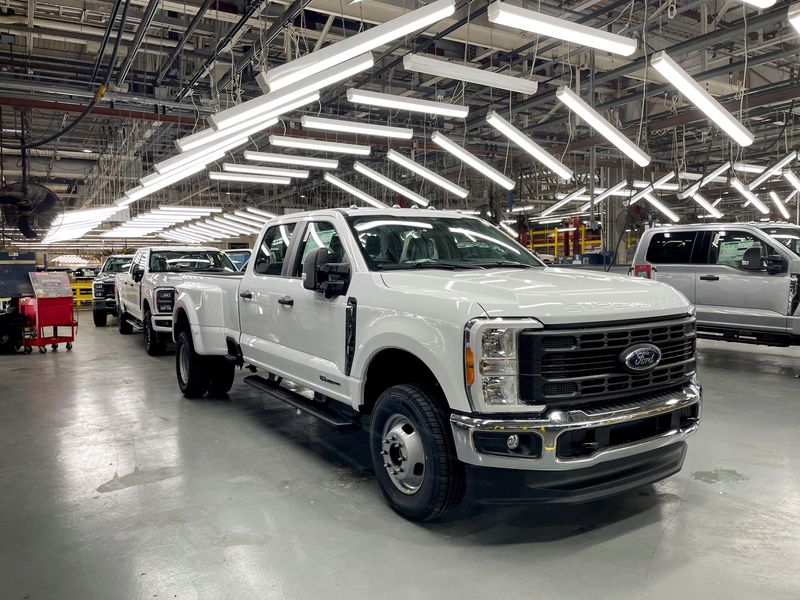By Lucia Mutikani
WASHINGTON (Reuters) - Production at U.S. factories rose in November, lifted by a rebound in motor vehicle output following the end of strikes, but activity was weaker elsewhere as manufacturing grapples with higher borrowing costs and softening demand.
Despite the manufacturing sector's mixed fortunes, the economy continued to expand as the year ended. A survey on Friday showed business activity picked up in December amid rising orders and demand for workers in the services industry.
"The broader economy keeps growing, but industrial production peaked way back in September 2022," said Christopher Rupkey, chief economist at FWDBONDS in New York. "Manufacturing continues to limp along and is unlikely to provide the fuel for economic growth in the near term."
Manufacturing output rose 0.3% in November, the Federal Reserve said. Data for October was revised lower to show production at factories falling 0.8% instead of by the previously reported 0.7%. Economists polled by Reuters had forecast factory output would rebound 0.4%.
Excluding motor vehicles and parts, manufacturing output slipped 0.2%. Overall production at factories decreased 0.8% on a year-on-year basis in November.
Manufacturing, which accounts for 10.2% of the economy, continues to be hamstrung by higher interest rates. Despite an easing in financial conditions and prospects of rate cuts next year, a rapid improvement in factory output is not expected amid signs that businesses are throttling back on inventory accumulation in anticipation of softer demand.
A survey from the Institute for Supply Management this month found that manufacturers viewed customer inventories as having increased "toward the upper end of 'about-right' territory" in November. The ISM's manufacturing PMI has remained in contraction territory for 13 straight months, the longest such stretch since the August 2000-January 2002 period.
The Fed held interest rates steady on Wednesday and signaled in new economic projections that the historic tightening of monetary policy engineered over the last two years is at an end and lower borrowing costs are coming in 2024.
The lackluster outlook for manufacturing was reinforced on Friday by the New York Fed's Empire State survey, which showed factory activity in the region sinking deeper into recession. The survey's general business conditions plunged 24 points to -14.5 this month, with new orders and employment measures stuck in negative territory.
Manufacturers in the region were not overly optimistic that business conditions would improve over the next six months.
Stocks on Wall Street were mixed. The dollar rose against a basket of currencies. U.S. Treasury prices were unchanged.
BUSINESS ACTIVITY RISES
A third report, from S&P Global, showed its flash manufacturing PMI falling to 48.2 in December amid shrinking orders from 49.4 in November. But the survey's flash services sector PMI rose to 51.3 from 50.8 with new orders, employment and input prices sub-components all rising.
That lifted the S&P Global's flash Composite PMI Output Index, which tracks the manufacturing and services sectors, to a five-month high of 51.0 from 50.7 in November.
Sentiment surveys, such as the ISM and Empire State, however, likely overstate the weakness in manufacturing. The report from the Fed showed pockets of strength.
Motor vehicle and parts output rebounded 7.1% last month, recouping the bulk of the 9.9% decline in October, after the end of the United Auto Workers' 1-1/2-months long strikes against Detroit's "Big Three" automakers. Motor vehicle production was expected to accelerate as plants returned to full capacity.
"Auto suppliers, who were negatively impacted by the latest strike and had to lay off workers, are requiring time to return operations to pre-strike levels," said Bernard Yaros, a leadU.S. economist at Oxford Economics. "We should see further gains in motor vehicle and parts output in the near term."
There were solid increases in production of computer and electronic products and aerospace and miscellaneous transportation equipment, which, together with output of motor vehicles and parts, helped boost durable manufacturing by 1.2%.
Output of high technology goods like computers, communications equipment and semiconductors and related components have soared this year, driven by the Biden administration's efforts to bring production back to the United States. Production of nondurable goods fell 0.5% amid steep drops in the output of textiles as well as apparel and leather.
Mining output rose 0.3% after falling 1.1% in October. Utilities production slipped 0.4% following a 1.4% plunge. Overall industrial production was up 0.2% in November after decreasing 0.9% in October.
Capacity utilization for the industrial sector, a measure of how fully firms are using their resources, edged up one-tenth of a percentage point to 78.8% in November.

The operating rate for the manufacturing sector rose to 77.2% from 77.0% in the prior month.
"Some stabilization in demand at lower levels, easing interest rates as the Fed cuts rates next year, as well as onshoring of supply networks and infrastructure spending may be supportive of factory activity in 2024," said Rubeela Farooqi, chief U.S. economist at High Frequency Economics in White Plains, New York.
